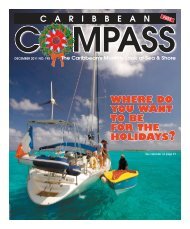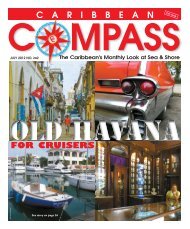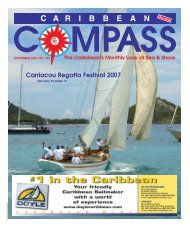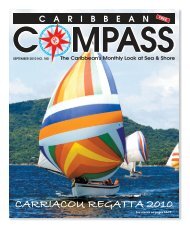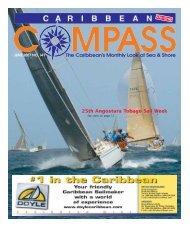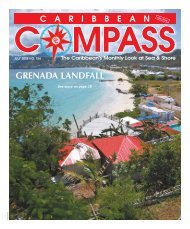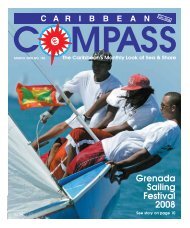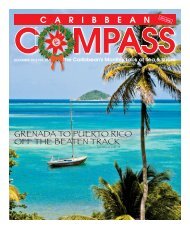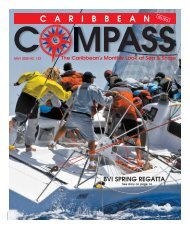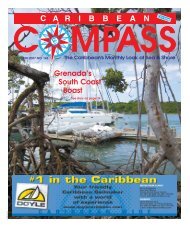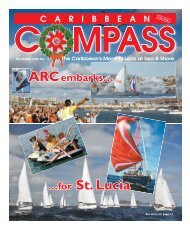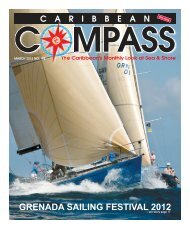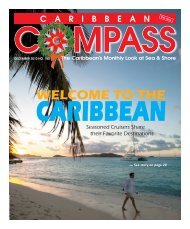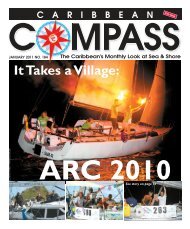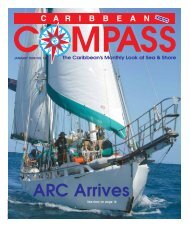Create successful ePaper yourself
Turn your PDF publications into a flip-book with our unique Google optimized e-Paper software.
JULY 2010 CARIBBEAN COMPASS PAGE 20<br />
MERIDIAN PASSAGE<br />
OF THE MOON<br />
Crossing the channels between <strong>Caribbean</strong> islands with a favorable tide will<br />
make your passage faster and more comfortable. The table below, courtesy Don<br />
Street, author of Street’s Guides and compiler of Imray-Iolaire charts, which<br />
shows the time of the meridian passage (or zenith) of the moon for this AND next<br />
month, will help you calculate the tides.<br />
Water, Don explains, generally tries to run toward the moon. The tide starts<br />
running to the east soon after moonrise, continues to run east until about an<br />
hour after the moon reaches its zenith (see TIME below) and then runs westward.<br />
From just after the moon’s setting to just after its nadir, the tide runs eastward;<br />
and from just after its nadir to soon after its rising, the tide runs westward; i.e.<br />
tide the floods from west to east. Times given are local.<br />
Note: the maximum tide is 3 or 4 days after the new and full moons.<br />
For more information, see “Tides and Currents” on the back of all Imray Iolaire<br />
charts. Fair tides!<br />
July<br />
DATE TIME<br />
1 0331<br />
2 0441<br />
3 0451<br />
4 0532<br />
5 0615<br />
6 0701<br />
7 0751<br />
8 0845<br />
9 0944<br />
10 1045<br />
11 1146 (new)<br />
12 1246<br />
13 1343<br />
14 1436<br />
15 1528<br />
16 1618<br />
17 1708<br />
18 1759<br />
19 1851<br />
JULY & AUGUST 2010<br />
20 1945<br />
21 2039<br />
22 2132<br />
23 2225<br />
24 2315<br />
25 0000 (full)<br />
26 0002<br />
27 0046<br />
28 0128<br />
29 0209<br />
30 0330<br />
August<br />
1 0411<br />
2 0455<br />
3 0542<br />
4 0633<br />
5 0728<br />
6 0827<br />
7 0927<br />
8 1027<br />
9 1126<br />
10 1222 (new)<br />
11 1316<br />
12 1419<br />
13 1501<br />
14 1553<br />
15 1646<br />
16 1740<br />
17 1835<br />
18 1929<br />
19 2021<br />
20 2112<br />
21 2159<br />
22 2244<br />
23 2327<br />
24 0000 (full)<br />
25 0008<br />
26 0049<br />
27 0129<br />
28 0210<br />
29 0253<br />
30 0338<br />
31 0427<br />
World Cruiser’s<br />
Online Resource<br />
www.bwsai wwww. www.<br />
w.bwsailing.com<br />
.bwsailing.co<br />
bwsailing.com i n g c co<br />
m<br />
√<br />
√<br />
√<br />
√<br />
√<br />
√<br />
2 Free Issues of<br />
Blue Water Sailing magazine<br />
100s of Boat Reviews<br />
Latest Cruising News & Notes<br />
Exclusive Link to Yachts for Sale<br />
BWS’s Cruising Classifieds<br />
Worldwide Marine<br />
Weather Forecasts<br />
The World’s Best Cruising Magazine<br />
JUST A SAIL<br />
by Larissa Stendie<br />
Sailing is pure magic; at once the most thrilling and relaxing activity I have ever<br />
enjoyed, and I fear I’m hopelessly hooked.<br />
We left Bequia early in the morning of January 21st on what became a 35-hour<br />
offshore and coastal sail. I loved taking my watches on the rough open stretches<br />
between islands where the current made the sail choppy and rollercoaster-like. We<br />
were generally heeled over at a steep angle, sailing hard on the wind, and so in using<br />
the head I’d brace myself against the door, and when trying to sleep between watches,<br />
I’d wedge on an edge and hope body parts didn’t fall completely asleep while the<br />
stressed dog leaned into me and panted 200 times a minute. We ate holding onto<br />
our plates, and tried to occupy our minds and bellies against seasickness (of which<br />
I’ve miraculously and mercifully had NONE… thus far), which made watches above<br />
deck preferable in rougher seas.<br />
During the day we passed close enough to St. Vincent to see into the little bay of<br />
Wallilabou where the first “Pirates of the <strong>Caribbean</strong>” film was shot. We couldn’t see much<br />
of the remaining set except for several storefronts, but the steep cliffs and lush vegetation<br />
brought memories back. A few minutes after passing the island, we sailed past a pod of<br />
pilot whales (which look like small black dolphins) cartwheeling and fishing.<br />
Shortly thereafter we set several heavy lines with gigantic hot-pink and shimmering<br />
blue squid-like lures to troll and test our luck. Apparently, and sadly, much of<br />
Dozens of shooting stars fell<br />
and the bright hammock of moon<br />
shed almost enough light to read…<br />
the <strong>Caribbean</strong> has been overfished to the point where large game fish are far offshore,<br />
and medium (edible) sized fish are tough to find near the islands. Later, as<br />
I was sleeping up front on the bow in a comfy, rolling depression lined with sailbags,<br />
Chris drew my attention to a large flock of seabirds that were diving for fish<br />
driven to the surface by schools of hunting tuna. In a synchronistic dance, the<br />
small fish were attacked from above and below, though all we could see were the<br />
dips and dives of the brown, black and white birds. As we sailed through the fray,<br />
we felt tugs on the lines, and though one escaped, I hand-reeled a two-foot blackfin<br />
tuna aboard. I was surprised by how little he fought, but he was partially drowned<br />
by being pulled behind the boat going six knots. Such a beautiful, delicate fish,<br />
with a black back, wide taxi-yellow stripe and spiky-looking tail fins, iridescent<br />
white belly, and these huge, liquid, expressive anime eyes. Chris filleted it almost<br />
immediately and I ate the freshest, sweetest sashimi ever, warm from the sun. It<br />
was the perfect size to feed the three of us for dinner with fresh avocados and limes<br />
from Bequia.<br />
With wetter weather systems passing, the sun set in shades of neon orange from<br />
behind violent-looking swaths of black cloud crossing the skies. We shot past a<br />
distantly visible St. Lucia in the afternoon, Martinique during the night, and after<br />
the scare on the 8:00PM watch — my first in the dark, when I lost my bearings and<br />
swung the boat which caused the boom to fly wildly across the deck (hopefully you<br />
only do that once) — when I came back on at midnight, I loved night sailing. Once<br />
comfortable with wind speed (about 20 knots that night), bearings (look to the stars,<br />
distant lights of land) and weather (dressed in foul-weather gear to foil the wind and<br />
spray), there were dozens of things to see. Both sky and sea were alive with stars as<br />
phosphorescence glowed on each cresting wave and scattered out from our wake in<br />
sparkling points. Dozens of shooting stars fell and the bright hammock of moon<br />
shed almost enough light to read, only occasionally obscured by fast-moving clouds,<br />
as Martinique glowed faintly orange in the east. Singing myself awake, I ran through<br />
repertoire I hadn’t thought of for years, struggling to remember all the words. I kept<br />
our heading almost due north while watching satellites whiz across, and tossing<br />
back little flying fish that landed on deck. On my own boat, I will hang pan-pipes off<br />
the cockpit, for from the small holes in railings for attaching wind-generators or<br />
radar, the wind plays flute on sailboats, and though tuneless, Aeolian, soulless, the<br />
sounds are otherworldly, ethereal, and haunting.<br />
Even when wet and chilled, I marveled that the best part of that fantastic day was that<br />
not a single unusual event occurred, and that all this is simply the norm cruising.<br />
The author sailed with Chris Morejohn and daughter Kalessin on their S/Y Hogfish<br />
Maximus. Larissa Stendie is a Canadian artist, activist and adventurer, in the<br />
<strong>Caribbean</strong> for the winter learning to sail. Visit her blog at www.lstendie.blogspot.com.



